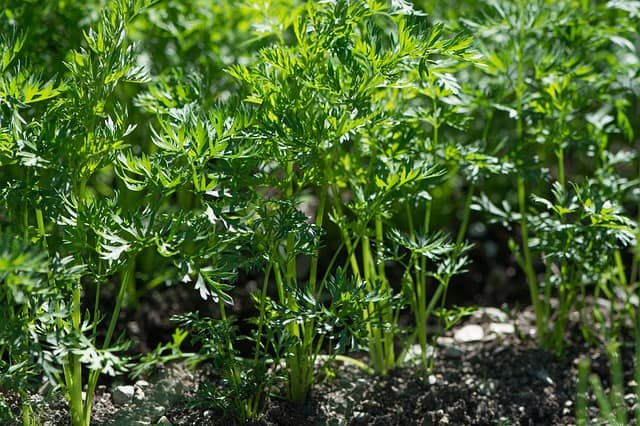Carrots are a great choice for people with small gardens. This root crop takes up minimal space while still delivering a good yield. The carrot root also contains very high amounts of beta-carotene, along with smaller amounts of vitamins C and K. Carrots come in many different colors, which range from the common orange color, which most people are used to, all the way to purple, with dozens of shades and colors in between.
Buy Carrot Seeds Online
| Image | Name | Rating | Shop |
|---|---|---|---|
 | Rainbow Carrot Blend | ||
 | Seeds of Change Certified Organic Garden Carrot Mix |
Best Soil for Carrot Cultivation
When choosing a variety, the most important concern should be your soil condition. If your soil is poor or rocky, you can grow carrots that produce short stout roots. If on the other hand, if you have high-quality, rock-free soil, then you can grow the long thick carrots that you see in the supermarket.
When Should You Plant Carrots?
Carrots are a cool season crop, which necessitates starting your planting early. It’s best not to start seeds indoors because transplanting outdoors later will lead to deformed roots. In most climates, the best time to plant carrot seed is 3 weeks before your last frost, with successive plantings every week, thereafter, for 2 to 3 weeks. This planting interval will give your carrot plants a head start on the warm weather while providing a successive harvest as the season progresses.
Planting Carrots

Growing Carrots in Raised Beds

As mentioned before, carrots need a very fine soil with no rocks or obstructions, in order to produce straight roots that don’t have any forks. If you cannot reasonably provide these conditions, you can always set up a raised bed (Buy Online) for your carrots.
Growing Carrots in Rocky Soil
If you plan on planting your carrots into your native soil, then be sure to till your soil deeply, sifting out any rocks you might find along the way.
Growing Carrots in Clay Soil
If your soil is hard or it has a high clay content, you can add compost, in order to loosen up the soil structure. Carrots also need a good amount of fertility in the soil, so adding a balanced, time-released fertilizer when you till the beds will help them get off to a good start.
Carrot Plant Spacing
Once you are ready to plant your seeds, you should space your seeds 7.5 inches (19 cm) apart, if you are planting into an intensive or raised bed; otherwise, plant them 3 inches (7.6 cm) apart, in rows spaced at 12 inches (30.5 cm). Once you have planted your seeds, you should soak the bed gently, being careful not to expose the shallowly planted seeds.
How Much Should You Water Carrots?

For the first 1 to 3 weeks, you should regularly water the seeds, because they are slow to germinate. Always be careful not to expose any seeds at this time; and if you see any seeds emerging from the soil, then gently cover them with a thin layer of soil. Once the seedlings emerge, they will be very fragile and care should be taken not to damage them while watering or weeding.
Mulching Carrots
If weeds do become a problem early in the season, carefully pinch the weeds out from in between the carrots. Once the carrot seedlings have grown to a height of about and 2 to 3 inches (5 to 7.5 cm), you may consider adding mulch to the planting area, in order to limit any further weeds and aid in moisture retention.
Carrot Plant Care

Thinning Carrots
As your carrots get larger, you can begin to thin out the weaker plants in order to allow the healthiest plants to develop large thick roots. You can continue to thin the beds for another couple of weeks until you are satisfied that the carrots are not overcrowded and that all small and weak carrot plants have been removed. This is a very necessary step because the strong, healthy carrot plants will suffer, if left in a crowded bed all season, producing thin malformed roots.
Carrot Pests and Diseases

Check for pests throughout the season. One possible insect to watch for is the Black Swallowtail butterfly! While some may find this bug beautiful, if you see it hovering around your plants, you should check the foliage for any caterpillars and remove them immediately then apply Bacillus Thuringiensis (Buy Online). Other pest problems are usually closer to the ground, such as the carrot root fly and nematodes, which can damage the crowns of your plants, so always check the base of your plants for any signs of damage.
When are Carrots Ready to Harvest?
About 70 to 80 days after you planted your carrots, you can begin to check and see if any are ready to be harvested. You can gently push the foliage back and look for root crowns that are starting to push out above the soil line. Carrots are usually ready to harvest when the crowns are at least three-quarters of an inch (2 cm) thick.
Can You Leave Carrots in the Ground too Long?
You don’t have to rush to pick them, because the longer you let them sit, the thicker and juicier they will become. Carrots also get sweeter if they are exposed to a few light touches of frost; therefore, in most cases, it’s best to leave a few in the garden well into the late fall and early winter. If you live in a climate that stays above 10 degrees Fahrenheit (-12 C), you can cover your carrots with a 6 inch (15 cm) layer of straw to “overwinter” them in the garden.
Storing Carrots After the Harvest
If you choose to store your carrots inside, they should keep for up to 6 months in your refrigerator, as long as they are kept at a high relative humidity. Another option is to chop the carrots, blanch them, and then place them in bags for storage in the freezer.






